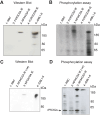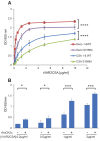Casein Kinases 2-dependent phosphorylation of the placental ligand VAR2CSA regulates Plasmodium falciparum-infected erythrocytes cytoadhesion
- PMID: 39804934
- PMCID: PMC11761665
- DOI: 10.1371/journal.ppat.1012861
Casein Kinases 2-dependent phosphorylation of the placental ligand VAR2CSA regulates Plasmodium falciparum-infected erythrocytes cytoadhesion
Abstract
Placental malaria is characterized by the massive accumulation and sequestration of infected erythrocytes in the placental intervillous blood spaces, causing severe birth outcomes. The variant surface antigen VAR2CSA is associated with Plasmodium falciparum sequestration in the placenta via its capacity to adhere to chondroitin sulfate A. We have previously shown that the extracellular region of VAR2CSA is phosphorylated on several residues and that the phosphorylation enhances the adhesive properties of CSA-binding infected erythrocytes. Here, we aimed to identify the kinases mediating this phosphorylation. We report that Human and Plasmodium falciparum Casein Kinase 2α are involved in the phosphorylation of the extracellular region of VAR2CSA. We notably show that both CK2α can phosphorylate the extracellular region of recombinant and immunoprecipitated VAR2CSA. Mass spectrometry analysis of recombinant VAR2CSA phosphorylated by recombinant Human and P. falciparum CK2α combined with site-directed mutagenesis led to the identification of residue S1068 in VAR2CSA, which is phosphorylated by both enzymes and is associated with CSA binding. Furthermore, using CRISPR/Cas9 we generated a parasite line in which phosphoresidue S1068 was changed to alanine. This mutation strongly impairs infected erythrocytes adhesion by abolishing VAR2CSA translocation to the surface of infected erythrocytes. We also report that two specific CK2 inhibitors reduce infected erythrocytes adhesion to CSA and decrease the phosphorylation of the recombinant extracellular region of VAR2CSA using either infected erythrocytes lysates as a source of kinases or recombinant Human and P. falciparum casein kinase 2. Taken together, these results undoubtedly demonstrate that host and P. falciparum CK2α phosphorylate the extracellular region of VAR2CSA and that this post-translational modification is important for VAR2CSA trafficking and for infected erythrocytes adhesion to CSA.
Copyright: © 2025 Dorin-Semblat et al. This is an open access article distributed under the terms of the Creative Commons Attribution License, which permits unrestricted use, distribution, and reproduction in any medium, provided the original author and source are credited.
Conflict of interest statement
The authors have declared that no competing interests exist.
Figures








Similar articles
-
Phosphorylation of the VAR2CSA extracellular region is associated with enhanced adhesive properties to the placental receptor CSA.PLoS Biol. 2019 Jun 10;17(6):e3000308. doi: 10.1371/journal.pbio.3000308. eCollection 2019 Jun. PLoS Biol. 2019. PMID: 31181082 Free PMC article.
-
Chondroitin sulphate A (CSA)-binding of single recombinant Duffy-binding-like domains is not restricted to Plasmodium falciparum Erythrocyte Membrane Protein 1 expressed by CSA-binding parasites.Int J Parasitol. 2009 Sep;39(11):1195-204. doi: 10.1016/j.ijpara.2009.02.022. Epub 2009 Mar 24. Int J Parasitol. 2009. PMID: 19324047
-
A single full-length VAR2CSA ectodomain variant purifies broadly neutralizing antibodies against placental malaria isolates.Elife. 2022 Feb 1;11:e76264. doi: 10.7554/eLife.76264. Elife. 2022. PMID: 35103596 Free PMC article.
-
VAR2CSA-Mediated Host Defense Evasion of Plasmodium falciparum Infected Erythrocytes in Placental Malaria.Front Immunol. 2021 Feb 9;11:624126. doi: 10.3389/fimmu.2020.624126. eCollection 2020. Front Immunol. 2021. PMID: 33633743 Free PMC article. Review.
-
Cytoadhesion of Plasmodium falciparum-infected erythrocytes and the infected placenta: a two-way pathway.Braz J Med Biol Res. 2006 Dec;39(12):1525-36. doi: 10.1590/s0100-879x2006001200003. Braz J Med Biol Res. 2006. PMID: 17160261 Review.
References
-
- WHO. World Malaria Report 2022. ISBN 978-92-4-006490-4. (World Health Organization, Geneva, 2022). 2022.
MeSH terms
Substances
LinkOut - more resources
Full Text Sources

